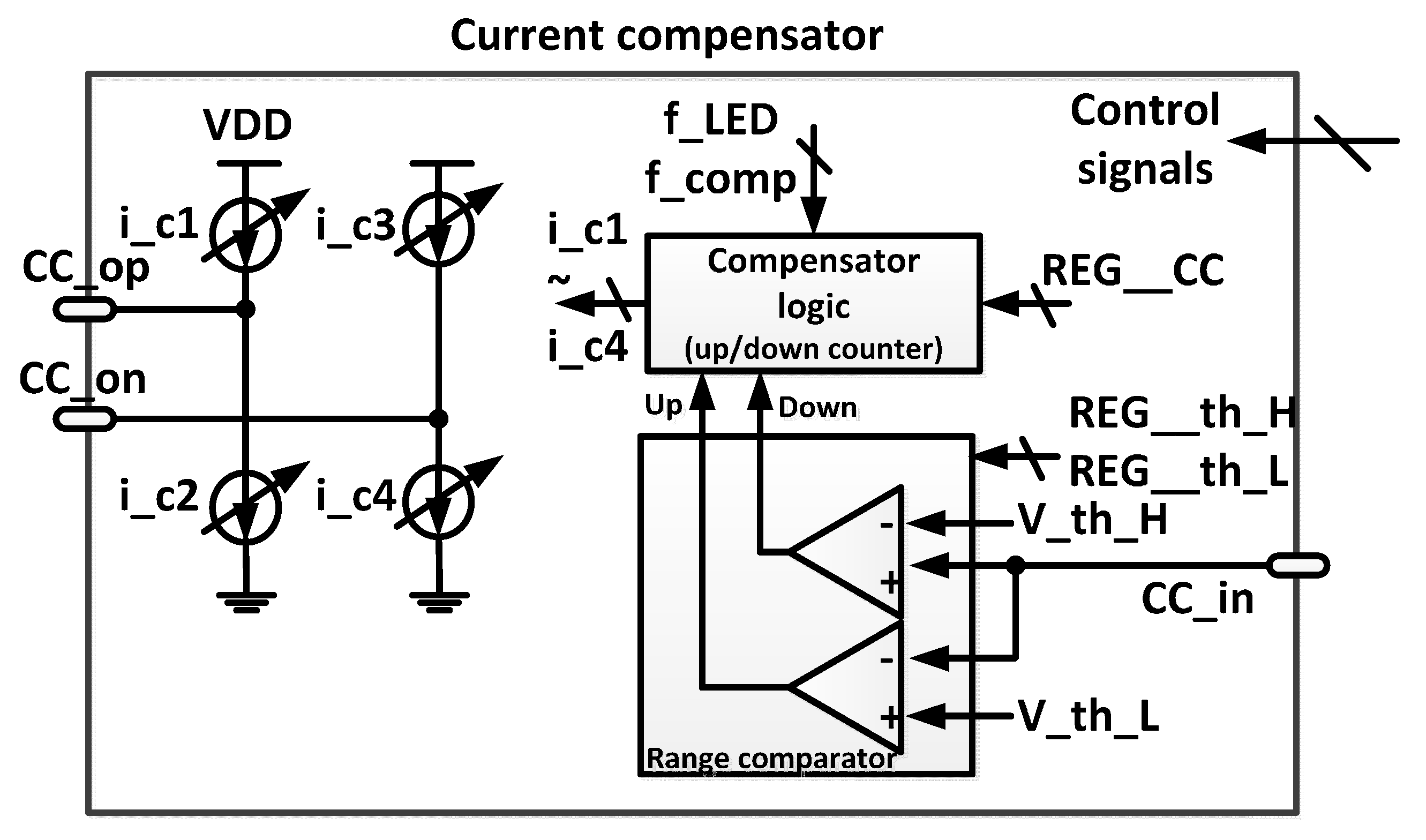Low-Power Photoplethysmogram Acquisition Integrated Circuit with Robust Light Interference Compensation
Abstract
:1. Introduction
2. Circuit Design
2.1. Top Architecture and Overall Work Flow

2.2. Fully Differential Transimpedance Amplifier (TIA)

2.3. Ambient Light Cancellation (ALC)


2.4. Automatic Offset Compensation (AOC)

2.5. Automatic Emitted Light Compensation (AEC)

3. Measurement Results and Discussion









4. Conclusions
| This Work | [11] | [12] | [13] | |
|---|---|---|---|---|
| Technology [μm] | 0.13 | 0.35 | 1.5 | 0.18 |
| Readout channel power consumption (w/o LED power) [μW] | 26.4 | N/A | 160 | 117 |
| Input referred noise [pArms] | 260 | N/A | N/A | N/A |
| Automatic offset compensation (AOC) | Yes | Yes | Yes | Yes |
| Ambient light cancellation (ALC) | Yes | No | No | No |
| Automatic emitted light compensation (AEC) | Yes | Yes | Yes | No |

Acknowledgments
Author Contributions
Conflicts of Interest
References
- Bortolotto, L.A.; Blacher, J.; Kondo, T.; Takazawa, K.; Safar, M.E. Assessment of vascular aging and atherosclerosis in hypertensive subjects: Second derivative of photoplethysmogram versus pulse wave velocity. Am. J. Hypertens. 2000, 13, 165–171. [Google Scholar] [CrossRef]
- Poon, C.; Zhang, Y. Cuff-less and noninvasive measurements of arterial blood pressure by pulse transit time. In Proceedings of the 27th Annual International Conference of the Engineering in Medicine and Biology Society (IEEE-EMBS 2005), Shanghai, China, 1–4 September 2005; pp. 5878–5880.
- Sant, L.; Fant, A.; Torta, P.; Dorrer, L. A system containing an ambient light and a proximity sensor with intrinsic ambient light rejection. In Proceedings of the 38th European Solid-State Circuit Conference (ESSCIRC 2012), Bordeaux, France, 17–21 September 2012; pp. 97–100.
- He, D.; Morgan, S.P.; Trachanis, D.; van Hese, J.; Drogoudis, D.; Fummi, F.; Hayes-Gill, B.R. A single-chip CMOS pulse oximeter with on-chip lock-in detection. Sensors 2015, 15, 17076–17088. [Google Scholar] [CrossRef] [PubMed]
- Tamura, T.; Maeda, Y.; Sekine, M.; Yoshida, M. Wearable photoplethysmographic sensors—Past and present. Electronics 2014, 3, 282–302. [Google Scholar] [CrossRef]
- Rhee, S.; Yang, B.; Asada, H. Artifact-resistant, power-efficient design of finger-ring plethysmographic sensors. IEEE Trans. Biomed. Eng. 2001, 48, 795–805. [Google Scholar] [CrossRef] [PubMed]
- Lee, Y.; Shin, H.; Jo, J.; Lee, Y. Development of a wristwatch-type PPG array sensor module. In Proceedings of the IEEE International Conference on Consumer Electronics, Berlin, Germany, 6–8 September 2011; pp. 168–171.
- Maeda, Y.; Sekine, M.; Tamura, T. Relationship between measurement site and motion artifacts in wearable reflected photoplethysmography. J. Med. Syst. 2011, 35, 969–976. [Google Scholar] [CrossRef] [PubMed]
- Poh, M.-Z.; Swenson, N.C.; Picard, R.W. Motion-tolerant magnetic earring sensor and wireless earpiece for wearable photoplethysmography. IEEE Trans. Inform. Tech. Biomed. 2010, 14, 786–794. [Google Scholar] [CrossRef] [PubMed]
- AFE4400 Integrated Analog Front-End for Heart Rate Monitors and Low-Cost Pulse Oximeters. Available online: http://www.ti.com/lit/ds/symlink/afe4400.pdf (accessed on 1 November 2015).
- Wong, A.; Pun, K.; Zhang, Y.; Leung, K. A low power CMOS front-end for photoplethysmographic signal acquisition with robust DC photocurrent rejection. In Proceedings of the 4th IEEE/EMBS International Summer School and Symposium on Medical Devices and Biosensors (ISSS-MDBS 2007), Cambridge, UK, 19–22 August 2007; pp. 53–56.
- Tavakoli, M.; Turicchia, L.; Sarpeshkar, R. An ultra-low-power pulse oximeter implemented with an energy-efficient transimpedance amplifier. IEEE Trans. Biomed. Circuits Syst. 2010, 4, 27–38. [Google Scholar] [CrossRef] [PubMed]
- Winokur, E.; O'Dwyer, T.; Sodini, C.G. A low-power, dual-wavelength photoplethysmogram (PPG) SoC with static and time-varying interferer removal. IEEE Trans. Biomed. Circuits Syst. 2015, 9, 581–589. [Google Scholar] [CrossRef] [PubMed]
- Ram, M.; Madhav, K.; Krishna, E.; Komalla, N.; Reddy, K. A novel approach for motion artifact reduction in PPG signals based on AS-LMS adaptive filter. IEEE Trans. Instr. Meas. 2012, 61, 1445–1457. [Google Scholar] [CrossRef]
- Peng, F.; Zhang, Z.; Gou, X.; Liu, H.; Wang, W. Motion artifact removal from photoplethysmographic signals by combining temporally constrained independent component analysis and adaptive filter. Biomed. Eng. Online 2014, 13. [Google Scholar] [CrossRef] [PubMed]
- Kim, J.; Lee, T.; Kim, J.; Ko, H. Ambient light cancellation in photoplethysmogram application using alternating sampling and charge redistribution technique. In Proceedings of the 37th Engineering in Medicine and Biology Society (IEEE-EMBC 2015), Milan, Italy, 25–29 August 2015; pp. 6441–6444.
- Xu, J.; Fan, Q.; Huijsing, J.H.; Van Hoof, C.; Yazicioglu, R.F.; Makinwa, K. Measurement and analysis of current noise in chopper amplifiers. IEEE J. Solid State Circ. 2013, 48, 581–589. [Google Scholar]
- Klumperink, E.A.; Gierkink, S.L.; Van Der Wel, A.P.; Nauta, B. Reducing MOSFET 1/f noise and power consumption by switched biasing. IEEE J. Solid State Circ. 2000, 35, 994–1001. [Google Scholar] [CrossRef]
© 2015 by the authors; licensee MDPI, Basel, Switzerland. This article is an open access article distributed under the terms and conditions of the Creative Commons by Attribution (CC-BY) license (http://creativecommons.org/licenses/by/4.0/).
Share and Cite
Kim, J.; Kim, J.; Ko, H. Low-Power Photoplethysmogram Acquisition Integrated Circuit with Robust Light Interference Compensation. Sensors 2016, 16, 46. https://doi.org/10.3390/s16010046
Kim J, Kim J, Ko H. Low-Power Photoplethysmogram Acquisition Integrated Circuit with Robust Light Interference Compensation. Sensors. 2016; 16(1):46. https://doi.org/10.3390/s16010046
Chicago/Turabian StyleKim, Jongpal, Jihoon Kim, and Hyoungho Ko. 2016. "Low-Power Photoplethysmogram Acquisition Integrated Circuit with Robust Light Interference Compensation" Sensors 16, no. 1: 46. https://doi.org/10.3390/s16010046







